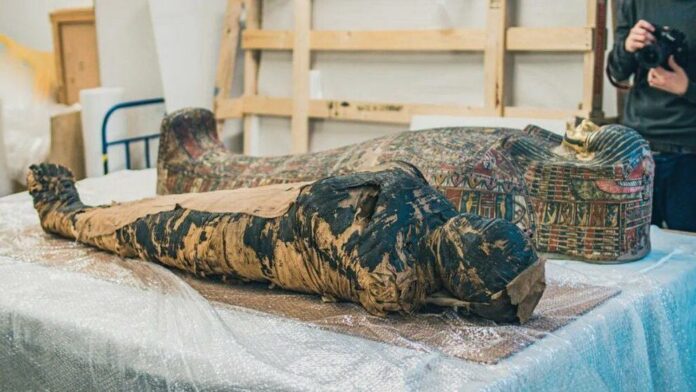Ancient Egyptian mummy shows evidence of nose cancer
Scientists have been busy trying to find the cause of death of the “Mysterious Lady,” a 2,000-year-old ancient Egyptian mummy whose womb contained an extremely well-preserved unborn fetus. By closely studying her skull, they suspect that this ancient soon-to-be mommy likely died of cancer — a discovery that’s blown the minds of oncologists and Egyptologists alike.
The “Mysterious Lady” Pregnant Mummy and sarcophagus.
Throughout the 19th and 20th centuries, this mummy was assumed to belong to a male priest. However, ground-breaking work by the Warsaw Mummy Project revealed it was, in fact, female. More surprises arose when they discovered she was also the first known example of a pregnant mummy.
Earlier this year, the Warsaw Mummy Project was astounded when CT scans of the “Mysterious Lady” revealed further evidence that the body’s pelvis cavity contained a fetus. Most remarkably, their study showed that the fetus had effectively been “pickled” by the highly acidic and low oxygen environment of the mummified womb, leaving it in remarkably good condition.
The researchers on the project told IFLScience that they often found themselves being asked how this young woman died, so they decided to find out. Further scans of the pregnant mummy’s skull revealed unusual signatures in the bone that suggest she was suffering from cancer.
Skull of the “Mysterious Lady,” a pregnant ancient Egyptian mummy.
In particular, markings on the skull shows signs that modern doctors see in patients with nasopharyngeal cancer, a rare type of cancer that impacts the part of the throat that runs between the back of the nose to the back of the mouth.
“A small pathological change, about 7 millimetres in diameter, a round lesion surrounding an empty space, can be seen on the CT scans, in the bone behind the left orbit. This is most likely a change made by a tumour, possibly a metastatic site,” Wojciech Ejsmond and Marzena Ozarek-Szilke, co-directors of the Warsaw Mummy Project, told IFLScience.
“This type of metastatic change on the bones of the skull occurs, among others, after adenoma, but if it was this type of tumour, histopathological tests will give us a definitive answer. In addition, there are large cavities in the bones of the face, including the nasal cavity, maxillary sinuses, and the palatal part of the maxillary bones,” Ejsmond and Ozarek-Szilke explained.
“The changes in the craniofacial bones are corresponding with nasopharyngeal cancer in modern patients.”
The yellow arrow is indicating a change made by a tumour, possibly a metastatic site, on the Mysterious Lady’s Skull.
To verify the cancer diagnosis, the researchers need to properly examine the mummy’s tissues. Identifying cancer within the actual tissues could also raise some other possibilities that scientists have excited about.
The team from the Warsaw Mummy Project says that oncologists could determine the “molecular signature” of cancer found in the mummy and then compare it with current cancers. This, they say, could provide some valuable insights into the evolution of cancer.
A bunch of ancient mummies have been discovered with possible signs of cancer in their bodies before. In 2017, scientists discovered the world’s oldest known cases of breast cancer and multiple myeloma in two ancient Egyptian mummies.
The two bodies, dating 2000 BCE and 1,800 BCE, were found buried at the pharaonic necropolis of Qubbet el-Hawa in Aswan and likely belonged to the elite classes of the governing Egyptian families of Elephantine.
Despite their riches and fame, nothing could save them from an untimely death.

